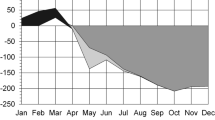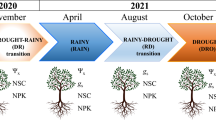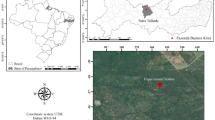Abstract
Nutrient resorption from senescing leaves is an important mechanism of nutrient conservation in temperate deciduous forests. Resorption, however, may be curtailed by climatic events that cause rapid leaf death, such as severe drought, which has been projected to double by the year 2100 in the eastern United States. During a record drought in the southeastern US, we studied 18 common temperate winter-deciduous trees and shrubs to understand how extreme drought affects nutrient resorption of the macronutrients N, P, K, and Ca. Four species exhibited drought-induced leaf senescence and maintained higher leaf water potentials than the remaining 14 species (here called drought-evergreen species). This strategy prevented extensive leaf desiccation during the drought and successfully averted large nutrient losses caused by leaf desiccation. These four drought-deciduous species were also able to resorb N, P, and K from drought-senesced leaves, whereas drought-evergreen species did not resorb any nutrients from leaves lost to desiccation during the drought. For Oxydendrum arboreum, the species most severely affected by the drought, our results indicate that trees lost 50% more N and P due to desiccation than would have been lost from fall senescence alone. For all drought-deciduous species, resorption of N and P in fall-senesced leaves was highly proficient, whereas resorption was incomplete for drought-evergreen species. The lower seasonal nutrient losses of drought-deciduous species may give them a competitive advantage over drought-evergreen species in the years following the drought, thereby impacting species composition in temperate deciduous forests in the future.




Similar content being viewed by others
References
Aerts R (1996) Nutrient resorption from senescing leaves of perennials: are there general patterns? J Ecol 84:597–608
Augé RM, Moore JL (2002) Stomatal response to nonhydraulic root-to-shoot communication of partial soil drying in relation to foliar dehydration tolerance. Environ Exp Bot 47:217–229
Augé RM, Duan XG, Croker JL, Witte WT, Green CD (1998) Foliar dehydration tolerance of twelve deciduous tree species. J Exp Bot 49:753–759
Bréda N, Huc R, Granier A, Dreyer E (2006) Temperate forest trees and stands under severe drought: a review of ecophysiological responses, adaptation processes and long-term consequences. Ann For Sci 63:625–644. doi:10.1051/forest:2006042
Chapin FS (1980) The mineral nutrition of wild plants. Annu Rev Ecol Syst 11:233–260
Côté B, Fyles JW, Djalilvand H (2002) Increasing N and P resorption efficiency and proficiency in northern deciduous hardwoods with decreasing foliar N and P concentrations. Ann For Sci 59:275–281. doi:10.1051/forest:2002023
Croker JL, Witte WT, Augé RM (1998) Stomatal sensitivity of six temperate, deciduous tree species to non-hydraulic root-to-shoot signaling of partial soil drying. J Exp Bot 49:761–774
Del Arco JM, Escudero A, Garrido MV (1991) Effects of site characteristics on nitrogen retranslocation from senescing leaves. Ecol 72:701–708
Duchesne L, Ouimet R, Camire C, Houle D (2001) Seasonal nutrient transfers by foliar resorption, leaching, and litter fall in a northern hardwood forest at Lake Clair Watershed, Quebec, Canada. Can J For Res 31:333–344
Eckstein RL, Karlsson PS, Weih M (1998) The significance of resorption of leaf resources for shoot growth in evergreen and deciduous woody plants from a subarctic environment. Oikos 81:567–575
Engelbrecht BMJ, Kursar TA (2003) Comparative drought-resistance of seedlings of 28 species of co-occurring tropical woody plants. Oecologia 136:383–393. doi:10.1007/s00442-003-1290-8
Hagen-Thorn A, Varnagiryte I, Nihlgard B, Armolaitis K (2006) Autumn nutrient resorption and losses in four deciduous forest tree species. For Ecol Manag 228:33–39. doi:10.1016/j.foreco.2006.02.021
Hocking PJ (1982) Effect of water stress on redistribution of nutrients from leaflets of narrow-leaved lupin (Lupinus angustifolius L.). Ann Bot 49:541–543
Killingbeck KT (1984) Nitrogen and phosphorus resorption dynamics of five tree species in a Kansas gallery forest. Am Midl Nat 111:155–164
Killingbeck KT (1992) Inefficient nitrogen resorption in a population of ocotillo (Fouquieria splendens), a drought-deciduous desert shrub. Southwest Nat 37:35–42
Killingbeck KT (1996) Nutrients in senesced leaves: keys to the search for potential resorption and resorption proficiency. Ecol 77:1716–1727
Killingbeck KT (2004) Nutrient resorption. In: Noodén LD (ed) Plant cell death processes. Elsevier, Amsterdam, pp 215–226
Killingbeck KT (2008) Can zinc influence nutrient resorption? A test with the drought-deciduous desert shrub Fouquieria splendens (ocotillo). Plant Soil 304:145–155. doi:10.1007/s11104-007-9530-z
Killingbeck KT, May JD, Nyman S (1990) Foliar senescence in an aspen (Populus tremuloides) clone: the response of element resorption to interramet variation and timing of abscission. Can J For Res 20:1156–1164
Larcher W (2003) Physiological plant ecology, 4th edn. Springer, Berlin
Likens GE, Driscoll CT, Buso DC, Siccama TG, Johnson CE, Lovett GM, Fahey TJ, Reiners WA, Ryan DF, Martin CW, Bailey SW (1998) The biogeochemistry of calcium at Hubbard Brook. Biogeochem 41:89–173
May JD, Killingbeck KT (1992) Effects of preventing nutrient resorption on plant fitness and foliar nutrient dynamics. Ecol 73:1868–1878
Minoletti ML, Boerner REJ (1994) Drought and site fertility effects on foliar nitrogen and phosphorus dynamics and nutrient resorption by the forest understory shrub Viburnum acerifolium L. Am Midl Nat 131:109–119
Munné-Bosch S, Alegre L (2004) Die and let live: leaf senescence contributes to plant survival under drought stress. Funct Plant Biol 31:203–216. doi:10.1071/FP03236
Murphy P, Lugo A (1986) Ecology of tropical dry forest. Annu Rev Ecol Syst 17:67–88
Nordell KO, Karlsson PS (1995) Resorption of nitrogen and dry-matter prior to leaf abscission variation among individuals, sites and years in the mountain birch. Funct Ecol 9:326–333
Oland K (1963) Changes in content of dry matter and major nutrient elements of apple foliage during senescence and abscission. Physiol Plant 16:682–694. doi:10.1111/j.1399-3054.1963.tb08346.x
Orwig DA, Abrams MD (1997) Variation in radial growth responses to drought among species, site, and canopy strata. Trees 11:474–484
Ostman NL, Weaver GT (1982) Autumnal nutrient transfers by retranslocation, leaching, and litter fall in a chestnut oak forest in southern Illinois. Can J For Res 12:40–51
Pallardy SG, Loewenstein NJ (2004) The role of xylem sap abscisic acid in leaf abcission of droughted seedlings of isohydric and anisohydric temperate deciduous angiosperms. In: Yaussy D, Hix DM, Goebel DC, Long RP (eds) 14th Central Hardwoods Forest Conference. Northeastern Research Station, US Department of Agriculture, Newtown Square, pp 365–372
Slot M, Poorter L (2007) Diversity of tropical tree seedling responses to drought. Biotropica 39:683–690. doi:10.1111/j.1744-7429.2007.00328.x
van Heerwaarden LM, Toet S, Aerts R (2003) Current measures of nutrient resorption efficiency lead to a substantial underestimation of real resorption efficiency: facts and solutions. Oikos 101:664–669
Acknowledgments
We thank Laura White at Hemlock Bluffs Nature Preserve and the staff at Fred G. Bond Metro Park for allowing us to work on public land. We also thank Joseph Kleiss for help in characterizing the soils from our study sites. This work was funded by the A.W. Mellon Foundation.
Author information
Authors and Affiliations
Corresponding author
Additional information
Communicated by Frederick C. Meinzer.
Rights and permissions
About this article
Cite this article
Marchin, R., Zeng, H. & Hoffmann, W. Drought-deciduous behavior reduces nutrient losses from temperate deciduous trees under severe drought. Oecologia 163, 845–854 (2010). https://doi.org/10.1007/s00442-010-1614-4
Received:
Accepted:
Published:
Issue Date:
DOI: https://doi.org/10.1007/s00442-010-1614-4




